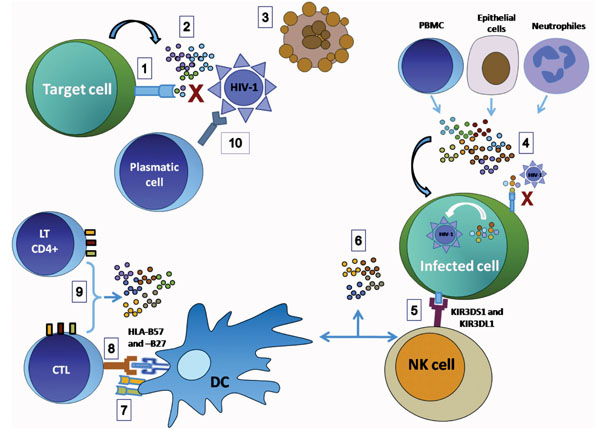Fig. (1) Mechanisms of resistance involved in the protection against HIV-1-infection and AIDS-progression. Target cells have polymorphisms in CCR5 gene or other alternative viral coreceptors, such as CCR2 (1), all of them induce low or non-expression of these coreceptors, inhibiting viral entry. This step can be also blocked by high production of the coreceptors ligands, MIP-1α/β, RANTES and SDF-1 (2). Elevated spontaneous and inducible apoptosis of monocytes and other HIV-1-target cells has been reported in ESNs (3). Increased release of soluble antiviral factors APOBEC3G, CAF, α and β- defensins, type I IFN, LIF, MIP-1α/β, RANTES, RNases, SDF-1, SLPI, TRIM5α and elafin block viral entry or replication (4). ESNs individuals exhibit high activity in NK cells and DCs. NK cells express KIR3DS1 and KIR3DL1 related to cell activation (5) and are able to produce IFN-γ (6). DCs also express the co-stimulatory molecules CD80 and CD86 (7) and produce IFN-α (6). Type I IFN induces HLA expression, apoptosis of infected cells, production of antiviral molecules, and block viral replication. The specific immune response is characterized by the presence of CTLs restricted to HLA-B57 and –B27, presenting immunodominant peptides (8), production of cytokines such as RANTES, MIP-1β, IL-6, IFN-γ, TNF-α and β and IL-2 that increase the immune response and expression of markers associated with T cell activation (9). B-cells produce neutralizing IgA antibodies, detectable in serum, mucosa and breast milk (10).


